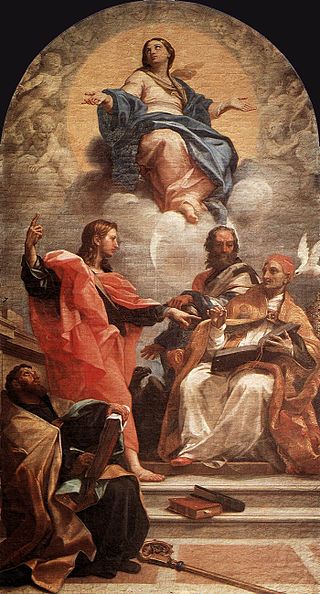
Our Lady of Immaculate Conception

Our Lady of Immaculate Conception, according to the teaching of the Catholic Church, was the conception of the Blessed Virgin Mary in the womb of her mother, Saint Anne, free from original sin by virtue of the foreseen merits of her son Jesus Christ. The Catholic Church teaches that Mary was conceived by normal biological means, but God acted upon her soul (keeping her “immaculate”) at the time of her conception.
The Immaculate Conception is commonly and mistakenly taken to mean the conception of Mary’s son Jesus Christ in her own womb, and the Virgin Birth of Jesus. These are covered by the Doctrine of Incarnation, while the Immaculate Conception deals with the conception of Mary herself, not that of her son.
Although the belief that Mary was sinless and conceived immaculate has been widely held since Late Antiquity, the doctrine was not dogmatically defined until 1854, by Pope Pius IX in his papal bull Ineffabilis Deus. The Catholic Church celebrates the Feast of the Immaculate Conception on December 8; in many Catholic countries, it is a holy day of obligation or patronal feast, and in some a national public holiday.
The defined dogma of the Our Lady of Immaculate Conception regards original sin only, saying that Mary was preserved from any stain (in Latin, macula or labes, the second of these two synonymous words being the one used in the formal definition). The proclaimed Roman Catholic dogma states “that the most Blessed Virgin Mary, in the first instance of her conception, by a singular grace and privilege granted by Almighty God, in view of the merits of Jesus Christ, the Saviour of the human race, was preserved free from all stain of original sin.” Therefore, being always free from original sin, the doctrine teaches that from her conception Mary received the sanctifying grace that would normally come with baptism after birth.
The definition makes no declaration about the Church’s belief that the Blessed Virgin was sinless in the sense of freedom from actual or personal sin. However, the Church holds that Mary was also sinless personally, “free from all sin, original or personal”. The Council of Trent decreed: “If anyone shall say that a man once justified can sin no more, nor lose grace, and that therefore he who falls and sins was never truly justified; or, on the contrary, that throughout his whole life he can avoid all sins even venial sins, except by a special privilege of God, as the Church holds in regard to the Blessed Virgin: let him be anathema.
A feast of the Conception of the Most Holy and All Pure Mother of God was celebrated in Syria on 8 December perhaps as early as the 5th century. Note that the title of achrantos (spotless, immaculate, all-pure) refers to the holiness of Mary, not specifically to the holiness of her conception.
Mary’s complete sinlessness and concomitant exemption from any taint from the first moment of her existence was a doctrine familiar to Greek theologians of Byzantium. Beginning with St. Gregory Nazianzen, his explanation of the “purification” of Jesus and Mary at the circumcision (Luke 2:22) prompted him to consider the primary meaning of “purification” in Christology (and by extension in Mariology) to refer to a perfectly sinless nature that manifested itself in glory in a moment of grace (e.g., Jesus at his Baptism). St. Gregory Nazianzen designated Mary as “prokathartheisa (prepurified).” Gregory likely attempted to solve the riddle of the Purification of Jesus and Mary in the Temple through considering the human natures of Jesus and Mary as equally holy and therefore both purified in this manner of grace and glory. Gregory’s doctrines surrounding Mary’s purification were likely related to the burgeoning commemoration of the Mother of God in and around Constantinople very close to the date of Christmas. Nazianzen’s title of Mary at the Annunciation as “prepurified” was subsequently adopted by all theologians interested in his Mariology to justify the Byzantine equivalent of the Immaculate Conception. This is especially apparent in the Fathers St. Sophronios of Jerusalem and St. John Damascene, who will be treated below in this article at the section on Church Fathers. About the time of Damascene, the public celebration of the “Conception of St. Ann [i.e., of the Theotokos in her womb]” was becoming popular. After this period, the “purification” of the perfect natures of Jesus and Mary would not only mean moments of grace and glory at the Incarnation and Baptism and other public Byzantine liturgical feasts, but purification was eventually associated with the feast of Mary’s very conception (along with her Presentation in the Temple as a toddler) by Orthodox authors of the 2nd millennium (e.g., St. Nicholas Cabasilas[17] and Joseph Bryennius).[18]